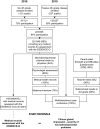The ESSENCE-Questionnaire in Medical Records Screening for Neurodevelopmental Symptoms/Problems: Utility and Clinical Validity
- PMID: 36353466
- PMCID: PMC9639423
- DOI: 10.2147/NDT.S367196
The ESSENCE-Questionnaire in Medical Records Screening for Neurodevelopmental Symptoms/Problems: Utility and Clinical Validity
Abstract
Purpose: Determine the prevalence of symptoms of neurodevelopmental problems (NDPs) with a semi-structured review of fourth grade students' medical records, its interrater agreement and validity as compared with clinical assessment.
Methods: A school-based sample of 11-year-old children provided child health care (CHC) records and school health care (SHC) records. A pediatric neurologist, child psychiatrist and an adult psychiatrist scored the records, with the "Early Symptomatic Syndromes Eliciting Neurodevelopmental Clinical Examinations-Questionnaire" (ESSENCE-Q, 12 items scored 0-2, summary score range 0-24). Agreement was measured with model-based kappa and intraclass correlation coefficient (ICC). Ratings were validated against a multidisciplinary assessment involving a physician, psychologist, teacher- and parental behavioral rating scales rendering a clinical global impression severity rating (CGI-S, range 1-7) of NDPs.
Results: Out of 223 participants, medical charts were available from 201, of whom 169 were rated by all three raters. Kappa agreement was moderate/strong (~0.8) for 7 of the 12 questionnaire items. Measured with the ICC, concordance in the summary score was good for agreement (~0.8) and excellent (~0.9) for consistency. Test-retest reliability was excellent (ICC = ~0.9). Area under the curve for the ESSENCE-Q in predicting clinical-level problems (CGI ≥4) was ~80% for all three raters, albeit with differing optimal cutoffs.
Conclusion: Using the ESSENCE-Q as a template, NDPs appear to be common in medical records, are identified reliably, and predict clinical-level concern. Medical records screening may facilitate a structured review of medical records in work-ups or be applied in conjunction with other screening measures for neurodevelopmental disorders. However, differences in calibration currently preclude defining a universal cutoff for using the ESSENCE-Q for medical records screening.
Keywords: ESSENCE; abnormal development; child health; medical records; neurodevelopmental disorders.
© 2022 Landgren et al.
Conflict of interest statement
Dr Magnus Landgren reports grants from Research and Development of Region Västra Götaland, grants from Fund at Skaraborg Hospital, during the conduct of the study. The authors report no conflicts of interest.
Figures






References
LinkOut - more resources
Full Text Sources
Miscellaneous

